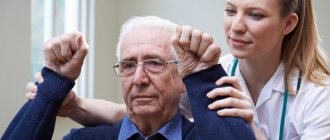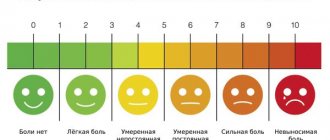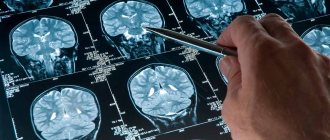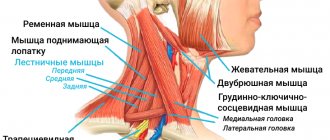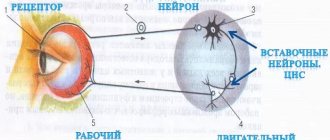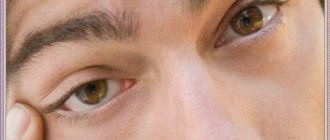Many pathologies are characterized by severe symptoms. However, in their absence, a person’s reflexes may indicate the presence of the disease. This is especially important when the patient is too young to describe symptoms in words.
Babinski's symptom is one of the most important, albeit pathological, reflexes. It is described as an abnormal response of the central nervous system to an irritating mechanical stimulus. Which is not only an indicator of a disruption in its functioning, but also the consequences of other equally serious diseases.
What is Babinski's sign?
A person's involuntary reflexes, controlled by his nervous system, are the brain's response to various stimuli. The value of this kind of data for making a diagnosis is that a person cannot manage it independently. It is not possible to hide such a reaction, whether intentionally or not.
Any qualified neurologist knows what Babinski’s symptom is. For people without medical education, it can be difficult to understand its meaning. It is necessary to have a general understanding of the functioning of the human central nervous system, its perception of external signals, methods of processing and output.
Under the influence of external stimuli, nerve endings form impulses that are transmitted to the brain. Analyzing the information received from them, it issues response impulses. Simply put, commands for skeletal muscles with an algorithm for further actions.
Depending on the situation, this could be:
- jerking;
- redistribution of equilibrium;
- block on muscle activity;
- flexion;
- extension.
Babinski's sign is a reflex, which is a pathological reaction of the toes, accompanied by their extension. The peculiarity is that normally, when a certain area of the foot is impacted, a command should be received to bend its muscles downward. The above symptom has age-related exceptions due to insufficient development of the cerebral cortex.
After carrying out manipulations to test the reflex, the result can be positive or negative. In medical practice, there are cases of false-positive interpretation of the result, which were subsequently not confirmed by additional diagnostic methods.
https://www.youtube.com/watch?v=FWrVB_2U5bY
Manifestations in children
The situation with the Babinski reflex in children is far from ambiguous - the symptom up to a certain age can be attributed to a variant of immaturity of the nervous structures. It will definitely be checked in babies who have just been born. Normally it is positive, on both sides. A negative result from Babinsky's study may indirectly indicate pathologies of the nervous system such as cerebral palsy or a congenital tumor.
As the connections between nerve cells and fibers strengthen, the reflexes in newborns change - some of them weaken, while others strengthen. Up to two to three years, the system is constantly rebuilt and adapts to changes inside and outside the body.
Later manifestations of the Babinski reflex after 3-4 years should cause natural anxiety - by this age the symptom gradually fades away. However, its presence may indicate either underdevelopment of parts of the nervous system, or a hidden pathology. It is often caused by brain injury in children.
The prognosis will depend on the timing of diagnosis - identification of Babinsky's symptom, as well as treatment measures followed by rehabilitation. The child's body is flexible and has great potential for recovery. Therefore, with appropriate therapy, the child will develop according to age.
Mechanism of occurrence
What Babinski's symptom is can be understood by studying the mechanism of its occurrence. An impulse entering the brain with information about the presence of a stimulus in the foot area is analyzed by cells of the cerebral cortex.
In Betz's pyramidal cells, a response, motor or inhibitory impulse is formed, transmitted along the descending pathway. As a result of this process, the muscles of the foot contract, indicating a positive or negative result.
The path that ensures the delivery of the response signal to the skeletal muscles is called the pyramidal nerve tract. When the impulse has passed through the ascending path to the brain and descending along this tract without obstruction, the toes bend down towards the foot. Such a reaction to an irritant is considered normal.
We can talk about a pathological Babinski symptom when the result is the opposite. Namely, the thumb is extended, the rest are spread wide to the sides, forming something like a fan in shape.
Etiology
The structure of the central nervous system in humans involves a complex scheme of subordination of some structures - on the periphery, and others - the cerebral cortex and subcortical centers. To accomplish the task at hand - transmitting an electrical impulse, or command, so-called nerve tracts are provided. One of the most important is the pyramid path. Along it, impulses move from the brain to the muscle groups of the skeleton.
The mechanism of control over human movements involves performing not only voluntary contractions - on command, but also involuntary - unconscious ones, as well as a ban on motor activity. For example, in a situation where a sharp foreign object gets into a shoe, a pain signal is immediately sent to the cerebral cortex - but in order to prevent a person from falling, the leg muscles stop bending after the first involuntary contractions. The balance is not broken.
If damage to the pyramidal tract occurs, Babinski's sign will be positive. This means that the inhibitory function of the motor nerve pathway has been lost. Such disorders are possible both on one side and on both sides at once - bilateral damage.
Main reasons:
- neuroinfections – inflammation of the nerve fiber of a bacterial or viral nature;
- vascular accidents - strokes;
- traumatic brain injuries;
- autoimmune disorders – multiple sclerosis;
- neoplasms – benign/malignant tumors;
- intracranial hypertension.
The significance of the Babinski reflex can only be assessed by a specialized doctor - a neurologist. After all, there are periods in people’s lives when a failure in the pyramidal tract is a sign of a nervous system that has not yet fully matured. In some situations, the symptom accompanies injury to the tendons of the limbs.
What does one-sided and two-sided reflex mean?
In medical practice, there are cases when a pathological reflex is observed on both feet of the patient. In an adult, this situation indicates the severity of the disease that led to this result. In most cases, these are infectious or inflammatory processes occurring in the spinal cord or brain, affecting its central motor neuron.
Below are a number of diseases in which bilateral Babinski's sign often appears:
- meningitis;
Meningitis in adolescents. Symptoms - spinal cord tuberculosis;
- chronic progressive diseases of the central nervous system;
- spinal paralysis;
- head injuries;
- increased intracranial pressure;
- damage to the pyramidal tract;
- rabies.
Early detection of the symptom is important. This is due to the fact that many diseases have a high rate of development. The consequences of delaying diagnosis and treatment of the disease lead to irreversible consequences for the patient’s body.
To complete the clinical picture, in addition to the Babinsky reaction itself, accompanying signs are taken into account, with the help of which the lesion can be more accurately determined.
Associated signs of damage to the brain or spinal cord:
| Sign | Spinal cord | Upper motor neuron |
| Reflex response | Fast and pronounced | Slow and tonic |
| Big toe extension | Long-term | Short term |
| Paresis | Proximal | Distal |
| Superficial abdominal reflexes | None | Fine |
| Other signs | Pelvic disorders | Hyperreflexia, synkinesis |
It is not possible to make a full diagnosis based on reflexes and signs alone. However, this is enough to determine the direction of further diagnosis and early detection of diseases.
Cause of pathology
Certain brain cells are responsible for forming and sending impulses. They also control the inhibition of constant motor impulses of neurons in the anterior horns of the spinal cord.
It is thanks to the constant inhibitory impulse that pathological muscle contractions do not occur. Based on the mechanism of occurrence of Babinski’s symptom, it follows that the causes of the pathology can be disturbances in the functioning of the central nervous system of various types:
- injuries;
- infections;
- congenital developmental anomalies;
- inflammatory processes;
- hemorrhages;
- tumors of various types;
- sclerotic changes;
- tissue swelling.
Not only the nature of the lesion is distinguished, but also the place of its occurrence. The source of the disease can be located both in the brain itself and in the fibers of the spinal cord. This pathological reflex can be interpreted ambiguously when the patients are children, especially those under two years of age.
In newborns
Babinski's symptom in newborns and children under 2 years of age is not always a pathology. The positive reflex in this case manifests itself for physiological reasons. Namely, the weak development of the cerebral cortex, its cells responsible for the formation and processing of impulses.
At this time, the central nervous system, including the pyramidal tract, is just beginning to improve the system of transmitting impulses to the brain and back to the source of the stimulus.
In other children
As a child grows up, all systems of his body develop and improve their functioning. In cases where the child is 2 years old or more, the appearance of an extensor reflex may indicate a disorder. For a pediatric neurologist, the presence of this symptom will be the basis for regular examinations and monitoring of the patient over time.
On the one hand, each organism is unique, and the time required to debug all processes in it may vary. On the other hand, the sooner a symptom is identified, the more complete an anamnesis a specialist can make. This means performing additional diagnostics, scheduling consultations with other specialists, taking measures to prevent the progression of the detected disease, and prescribing the correct treatment.
In adults
Unlike children, in adults Babinski's symptom is always a pathology. If it is identified, a further set of measures will be aimed at diagnosing the cause and severity of the disease.
Causes of Babinski's sign in the brain and spinal cord:
| Brain | Spinal cord |
|
|
The pathological conditions listed in the table are not the entire list. There are diseases that can develop in both the brain and spinal cord.
Having a detrimental effect on their structure and functioning, for example:
- multiple sclerosis;
- tumor;
- cyst;
- injuries;
- infections;
- destruction of the membrane of neurons.
The manifestation of Babinski's sign on two feet may indicate a severe degree of the disease or the presence of several foci.
Manifestations in children
The situation with the Babinski reflex in children is far from ambiguous - the symptom up to a certain age can be attributed to a variant of immaturity of the nervous structures. It will definitely be checked in babies who have just been born. Normally it is positive, on both sides. A negative result from Babinsky's study may indirectly indicate pathologies of the nervous system such as cerebral palsy or a congenital tumor.
As the connections between nerve cells and fibers strengthen, the reflexes in newborns change - some of them weaken, while others strengthen. Up to two to three years, the system is constantly rebuilt and adapts to changes inside and outside the body.
Later manifestations of the Babinski reflex after 3-4 years should cause natural anxiety - by this age the symptom gradually fades away. However, its presence may indicate either underdevelopment of parts of the nervous system, or a hidden pathology. It is often caused by brain injury in children.
The prognosis will depend on the timing of diagnosis - identification of Babinsky's symptom, as well as treatment measures followed by rehabilitation. The child's body is flexible and has great potential for recovery. Therefore, with appropriate therapy, the child will develop according to age.
How to test your reflex at home?
Babinski's sign is one of the simple reflexes that does not require complex equipment or instruments to test. That is why it is available to everyone at home.
The procedure algorithm is as follows:
- The patient is positioned horizontally on a couch or bed, lying on his back. At the same time, the leg muscles are relaxed and the toes point upward.
- Holding the foot above the ankle joint with a non-sharp object (pen, pencil, toothpick with a cut off sharp edge), draw strokes along the outer edge of the foot.
- The direction of movement of the instrument starts from the heel to the ball of the foot, turning towards the big toe.
- The procedure is performed alternately on both legs. Pressing the selected tool should not cause pain.
An important point when checking the reflex is the integrity of the skin of the foot and the absence of injuries. If there is damage, the result may be incorrect.
Checking your reflexes at home can be a signal to contact a medical facility. Do not forget that only an experienced neurologist, taking into account the totality of all symptoms and signs, is able to give an adequate assessment of the situation.
The importance of the reflex in neurological and neurosurgical practice
The Babinski reflex is a universal, simple and reliable marker of damage to the pyramidal tract of the spinal cord and brain. No additional equipment is required to detect it. A hammer or other object with a ribbed, non-sharp edge that is safe for the skin is sufficient.
This is one of the most frequently identified symptoms during a neurological examination. A common finding during examination is Babinsky's symptom: every neurologist or neurosurgeon knows what it is and what to do next. Pediatricians are also oriented in what the Babinski reflex is. This pathological sign allows you to navigate further tactics of examination and treatment of such patients.
“After a stroke” is an Android application to help those caring for the patient at home.
Diagnostics in a medical facility
Babinski syndrome is the body’s first signal about the need for examination by a neurologist. The method of conducting a reflex test at home and in a medical institution differs only in the presence of a qualified specialist.
Experience and knowledge that allows us to take into account the general condition of the patient, various accompanying signals of the human body and decipher them. Despite the fact that the reflex itself already indicates the presence of pathology, a specialist can make a full diagnosis only based on the results of a complete diagnosis.
One of the first methods is laboratory and may include the following list:
- general blood analysis;
- biochemical;
- immunological tests.
There is another laboratory test for diagnosing diseases with the Babinski reflex. It differs from those listed above in its complexity and greater information content. A lumbar or lumbar puncture allows you to examine the composition of the fluid from the spinal cord.
Fluid is collected by a neurologist or an anesthesiologist in a medical facility. Sometimes the procedure is carried out for medicinal purposes. Removal of excess cerebrospinal fluid (cerebrospinal fluid), administration of medications for neuroinfections and oncology.
To study the condition of the blood vessels of the brain, its structure, and possible changes, cerebral angiography is performed. The essence of the procedure is to administer a contrast agent and further monitor its passage through the vessels of the area under study.
Upon completion, the patient receives several pictures and a video recording the results. To examine the spinal column, vertebral angiography is performed.
Diagnostics using magnetic resonance and computed tomography will help to exclude such causes of Babinski's symptom as:
- tumor compressing nerve fibers;
- tissue swelling as a result of injury;
- intracranial hematoma;
- other changes in the structure of human organs.
These methods are similar in information content, but MRI shows tissue more clearly, and CT results show bone structures. The most appropriate research method is selected by a specialist based on the medical history.
Positive result
Neurologists call Babinski's positive sign a reflex extension of the big toe, as well as a fan-like spreading of the others wide to the sides.
Experts consider this response of the central nervous system in adult patients and children over two years of age to a stimulus to be a sign of disorders.
Negative result
A negative result when testing for the Babinski reaction is considered normal. That is, a reflex contraction of the skeletal muscles of the foot to compress the toes during line irritation of the skin on its outer side.
False result
A false result or pseudo Babinski reflex occurs with peripheral paresis of the toe flexor muscles in neuropathy and myopathy. This reaction is caused by disruption of the tibial nerve and, as a consequence, paralysis of the flexor muscles.
Often, a false result means the presence of a symptom in newborns, however, experts do not use such a term in such cases. Since the presence of a positive reflex due to the patient’s age is considered normal.
Examination and diagnosis
The Babinski reflex is primarily a sign for the doctor about the need to examine this patient. What studies can help establish the location of this focus:
- MRI or SCT of the brain and/or spinal cord.
- PET positron emission tomography.
- Duplex scanning and angiography of cerebral vessels.
- ENMG - electroneuromyography (stimulation and needle).
- Lumbar puncture.
- clinical blood test.
What to do if Babinski's reflex is detected?
At the first symptoms and suspicions, consultation with a specialist is necessary. The task of a neurologist is to conduct the most detailed examination of all human reflexes. Based on the totality of signs, you can understand what diagnostic methods need to be applied.
Indeed, most often in cases of disorders in the brain and central nervous system as a whole, the speed of detection of the disease plays a role. This is important because many of them have a high rate of progression, and the consequences will be irreversible.
Therapy
Babinski's symptom is one of the pathological reflexes in which the therapeutic effect of treatment can occur only if the root cause of its occurrence is discovered.
Based on the results of a complete diagnosis, the doctor can make an accurate diagnosis. Treatment in this case will depend on the identified disease. The main direction of the fight is to prevent complete muscle paralysis due to the progression of the disease.
Depending on the disease, the following treatment methods can be used:
- immunotherapeutic (for mild degrees);
- medicinal (for mild and moderate severity);
- chemotherapy (malignant tumors);
- physical (massage, radio/UHF therapy, electrophoresis);
- surgical (if conservative treatment is ineffective).
The choice of method and treatment regimen are strictly individual for each patient. As a rule, in addition to the neurologist, other specialists in a narrow field of medicine participate in this process, depending on the disease.
In most cases, even with effective treatment, the patient requires long-term rehabilitation to restore lost functions. In severe illnesses, the recovery process is impossible, and the damage may be irreversible.
That is why preventive examinations by a neurologist and other specialists are necessary. A timely detected Babinski symptom for a person is an opportunity to prevent harmful consequences for the body.

